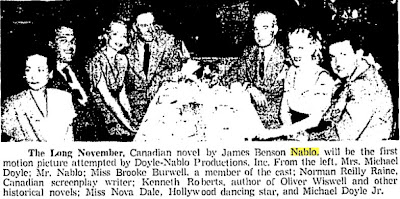The coming reissue of James Benson Nablo's The Long November has had me watching the films made from his stories. There were four in all, shot between 1953 and 1958, starring big names like Mickey Rooney, Edward G. Robinson and Victor Mature. Pretty impressive for someone who died six or so years after his arrival in Hollywood, don't you think?
Writing here four years ago, I described A Bullet for Joey, the second film made from a Nablo story as "god-awful". I haven't changed my mind. Still, I enjoy the movie, if only because it takes place in Montreal. A Bullet for Joey wasn't filmed in the city but at the RKO-Pathé Studios in California's Culver City. Lazy director Lewis Allen is content with stock footage, beginning with this establishing shot taken from Mount Royal.
…then blows it by cutting to an apartment building unlike any I've seen in Canada, outside of Vancouver.
We'll learn later that this is not an apartment building at all but a hotel… in a residential area… without signage… or a doorman.
Nuclear scientist Dr Carl Macklin, played by George Dolenz (Mickey's dad), emerges to greet a monkey and organ grinder.
Then he exchanges pleasantries with the friendly neighbour RCMP officer, in ill-fitting, faux-uniform.
The organ grinder will kill the officer as the monkey watches.
Enter Edward G. Robinson as Raoul Leduc, the RCMP inspector tasked with finding the murderer.
Note the portrait of Queen Elizabeth and the two maps of Canada. Allen may have been lazy, but set designer Joseph Kish was busy as a beaver placing STOP/ARRET signs, RCMP coats of arms and maps wherever possible. There are a lot of maps.
You've got to give Robinson credit for not falling into the trap that claimed Laurence Olivier in 49th Parallel; the actor never even attempts a French Canadian accent. He sometimes falters – Quebec is "Kweebec" – but for the most part his is a reliable performance; I was most impressed by the actor's ability to deliver lines like this with straight face: "An organ grinder? That early in the morning?"
You can hardly blame Robinson for his mispronunciations; the only Canadian I recognize in the credits is Henri Letondal, and the two share no scenes. Who was gonna set Rocco right?
Letondal plays a farmer who is being used by a foreign cabal to get a gangster into the country.
"Welcome to Canada, and to freedom Mister Steiner."That's George Raft as the gangster. He's been offered $100,000 to kidnap Macklin. Next thing you know it's old home week, with his crew descending on the Dubois farmhouse from Havana, Mexico City, Chicago and Los Angeles.
"Mister Dooboys?"
"Dubois. Your sponsor."
At this point the film loses focus with the would-be kidnappers posing as surveyors, factory workers and moonstruck lovers, all in an illogical effort to get close to the nuclear scientist. Although not shared with the audience, it appears that at some point the decision is made to steal the very project on which Macklin is working. This part of the movie is pretty boring, but pays off in one dynamite headline:
James Benson Nablo can't be blamed for this mess; it is his story, not his script. No Canadian would write dialogue like this:
"Two mornings a week Mr Macklin teaches physics at McGill University. He dines either at the club or the hotel."Montrealers will find it funny.
"What kind of a club?"
"The one to the faculty he belongs. After dinner he usually plays chess."
"Chess?"
"An intellectual game you wouldn't know about. When the weather is fine he plays golf – two or three afternoons a week. If it isn't, he goes up to Mount Royal to ski or skate."
Everyone will wonder why the movie features no character named Joey.
What Nablo himself thought about it all I haven't been able to discover.
Related posts:
























































